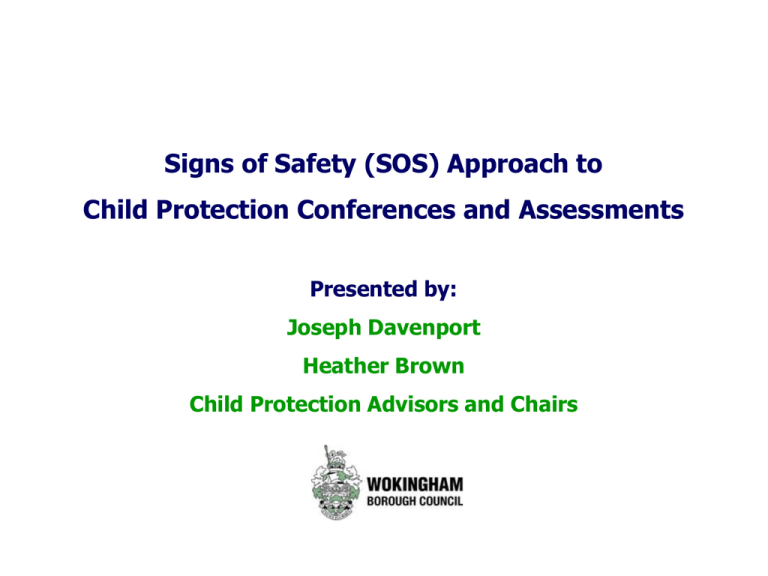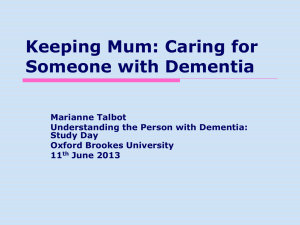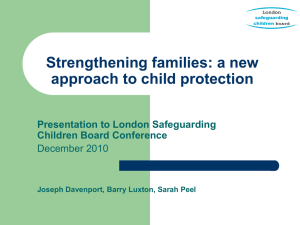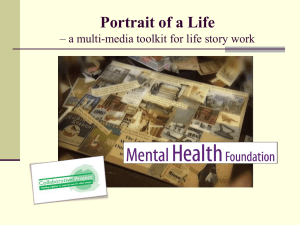Signs of Safety Presentation - Wokingham Children`s Services
advertisement

Signs of Safety (SOS) Approach to Child Protection Conferences and Assessments Presented by: Joseph Davenport Heather Brown Child Protection Advisors and Chairs Desired Outcome • Explore the evolution and experiences with traditional child protection conferences • Explore the evolution and research behind the Signs of Safety (SOS) model of child protection conferences • Explain how SOS assessment framework works and the development of SMART plans for children • Discuss the benefits and challenges to SOS conferences • Show what other family members and professionals have said about their experience with SOS conferences vs traditional format • Experience a mock SOS conference in action (Full day only) Evolution of Child Protection Conferences Emerged from the 1974 inquiry into the death of Maria Colwell due to lack of information and coordination amongst agencies involved Were professional’s only forums until the Cleveland Inquiry in 1988 where parents were invited to give proper consideration to the child’s interests No significant changes since Purpose: To be a multi-agency forum for sharing information amongst family and involved professionals in order to assess risks to children and decide if they require a Child Protection Plan (previously known as CP Register) to address identified risks of significant harm Frustration of Traditional Conferences • Parent’s feel “outnumbered” by professionals and very intimidated • Parent’s are more passive participants – their views do not matter • Parent’s feel being judged; a test of whether they will cooperate • Professionals want a more respectful, open, helpful, challenging, but less judgmental form of Social Work • Too much time is spent on information sharing, and very little on developing a plan to address concerns • Parents could not understand why they were being asked to do certain actions in the plan • Too much focus on concerns and deficits leaving parents feeling they are failures, rather than also recognizing any strengths • Often destroys working relationships with families and professionals Transition for Social Work Practice • Moving from conveyor-belt practice characterised by responsiveness to efficiency drivers, getting cases through the system, meeting targets, speedy casework resolution and general compliance with policy and practice guidelines. • To reflective practice characterised by critical reflection on issues, quality practice decision-making and interventions, depth of analysis, engagement with families and responsiveness to their needs while maintaining a child protection focus, mobilising supports and resources and access to critical supervision. Chapman and Field (2007) Research Suggests Conferences Should • Have a greater focus on planning for children • Enable families to present their views • Ensure all views are grounded in evidence • Promote discussion and explore dissent • Place a strong emphasis on working relationships • Reduce power inequalities • Build on existing strengths • Bring about change and improve outcomes for children Key Influences to SOS Approach • Solution Focused Therapy approaches pioneered by Steve de Shazer and Insoo Kim Berg • Andrew Turnell & Steve Edwards book “Signs of Safety” • Strengthening Families approach to conferences (West Berkshire) by Damian Griffiths • Family Group Conference model based on Maori values and practice in New Zealand and further developed by Olmsted County Child and Family Services in Minnesota • Messages from research: Farmer (1999), Millar and Young (1996), Campbell (1997), Bell (1996) Strengthening Families Framework Danger/Harm GENOGRAM/ECOMAP ℴ Detail re: incident(s) Bringing the family to the attention of the agency. ℴ Pattern/family history Safety • Strengths demonstrated as protection over time ℴ Pattern/history of exceptions Risk Statements Grey Area ℴ Risk to child(ren) ℴ Context of risk Safety Statement/ Outcomes •Description of the child’s care experience in positive terms Complicating Factors ℴ Condition/behaviours that contribute to greater difficulty for the family ℴ Presence of research based risk factors 1. 2. 3. 4. Next Steps What needs to change Who will do it When will they do it Etc. Strengths/Protective Factors ℴ Assets, resources, capacities within family, individual/community ℴ Presence of research based protective factors Lohrbach, S. & Sawyer, R (2004) Creating a constructive practice: family and professional partnership in high-risk child protection case conferences. Protecting Children, 19(2): 26-35. Difference To Traditional Conferences • More focus on managing risk and working around issues of denial in order to create safety for children and minimise the impact of harm • Transparent and clearer analysis of risks to children and of the information shared in the meeting • Greater recognition of existing strengths and safety factors to build upon • Acknowledging grey areas that need further clarity, rather than making assumptions not based in evidence • Engages professionals and parents as part of the solution • Seeks cooperation thus highlights lack of cooperation Difference To Traditional Conferences • More bespoke (SMART) plans for children that are owned by the conference and is not just the work of the Chair • Clearer understanding of what is expected of parents and what needs to change to reduce the risk of harm to children (desired outcome) • A more clear and comfortable forum for children and young people to attend and participate • Requires the Chair to be confident in facilitating discussions rather than being directive and prescriptive Munroe’s Review Relatively few children are removed permanently from their birth families and the main part of child protection work is helping parents provide better care. The work is informed by professional ethics, which include respect for culture, and a difficult combination of skills: being able to be authoritative and ask challenging questions about family life as well as engaging with parents in order to work with them to resolve their problems and improve their parenting capacity. Professionals can struggle with this. Some are so focused on supporting parents that they are insufficiently challenging of problematic parenting; others are so focused on checking that the child is safe that they enter an adversarial relationship with the parents. Sometimes the latter is unavoidable, however skilled the professional, but overall, successful engagement with the parents is a key contributor to effective helping. (Section 2.24) Munroe’s Review Children and young people are a key source of information about their lives and the impact any problems are having on them in the specific culture and values of their family. It is therefore puzzling that the evidence shows that children are not being adequately included in child protection work. (sec 2.5) The main reason why statutory guidance has grown is because advice on good practice has been added… those working in the field feel increasingly obliged to do things ‘by the book’ rather than use their professional judgment about children’s needs. (sec 3.14) Harm can never be totally prevented. Risk decisions should, therefore, be judged by the quality of the decision making, not by the outcome. (Principle 4) Helping children and families involves working with them and therefore the quality of the relationship between the child and family and professionals directly impacts on the effectiveness of help given. (Principles of an effective child protection system) The Signs of Safety Style of Child Protection Conferences Key Elements of SOS Conferences • Chair meets family first to explain process • Where space permits, opening the space in a horse shoe or semi circle format around the Chair and white board • Style of chairing is more facilitative versus directive • Succinct and transparent assessment and categorization of the information shared in the meeting that can be more clearly understood by professionals and family alike • Family have greater opportunities to respond and participate throughout • Use of scaling questions can be helpful in assessing and qualifying the risk of harm to children and likelihood of future harm Key Elements of SOS Conferences • Ensures the conference captures the history of risks and concerns while keeping the focus on creating safety and improved future outcomes for children • Ensures that decisions made, including the type of plan, is based in evidence and most effectively manages risks to children • Greater recognition that the expertise in supporting the children and their parents rests with the professionals working in partnership with the family and not solely with the Chair • Focus on creating a plan of action that involves the family in its creation rather than the designation of whether it needs to be a Child in Need or Child Protection Plan Room Layout Chair stands Chair sits White Board is natural focal point Traditional White Board Signs of Safety SOS Assessment Framework - Brent Unclear Concerns Current Risks/ Concerns Historic/ Complicating Ben injured during DV incident when he intervened and dad hit him Mum retracts DV statements to police Mum went to hospital after last DV incident, dad arrested. Ben says it is difficult to focus on school work due to conflicts at home. 8 reports of DV to police from 2002 to 2011 Mum and Ben want dad home, but bail prevents this and professionals worry about future DV Grey Areas When will it be safe for dad to return to the family home? What needs to change to sufficiently reduced risk of harm to Ben from DV? How can Ben have safe contact with his dad? Positives Safety/Protective Factors Mum calls the police when DV occurs Police bail prevents dad from returning home Ben trusts and confides in his teacher Mr Rodes about DV at home Strengths/ Positives Ben is always well presented Home clean and tidy. Lots of toys and books observed in Ben’s room Dad goes to all of Ben’s football practices & games SOS Assessment Framework - Hackney Safety related to Risks Historic Factors Current Risks or Dangers Safety Factors Grey Areas Complicating Factors Strengths Social Care involved since 2008 due to DV concerns Ben injured during DV incident when he intervened & dad hit him Mum calls the police when DV occurs When will it be safe for dad to return to the family home? Mum retracts DV statements to police Ben is always clean and well dressed 8 reports of DV with police from 2002 to 2011 Mum hospitalized with injuries for last DV incident Ben can’t focus on school work due to the arguments. Police bail prevents dad from returning home Ben trusts and confides in his teacher Mr Rhodes about the situation at home What needs to change to assure professionals that risk of harm to Ben from DV sufficiently reduced? How can dad and Ben have safe contact? Mum and Ben want dad home, but bail prevents this and Social Care have concerns about future DV incidents Dad goes to all of Ben’s football practices Ben has good school attendance Both parents affectionate with Ben Wokingham Signs of Safety Assessment Framework History Risks Grey Area Strengths/Safety What were we concerned about? What are we concerned about? What do we need to know more about? What is going well or reduces our concerns? Dad was living in the home and physically abusing mum in front of the children The children remain fearful of their father Would mum call the police if dad came to the home? Mum does not want to testify against dad in his criminal trial Can dad still have safe contact with his children? If so, how? Dad denies he assaulted mum and refuses to engage with professionals If mum cannot keep the children safe from DV, who else in the family or friends network can? The children were upset having witnessed DV between their parents The children had trouble sleeping and often wet the bed No concerns with basic parenting of the children (ie: food, hygiene, etc.) The children attend and do well in school No health concerns for the children Mum called police during last DV incident. Dad was arrested Making of the Child’s Plan Desired Outcome Actions By Whom By When Sally will live in a home that is kept clean, without rodents, no clutter, and that any hazards that may pose a risk of physical injury are eliminated. The parents agree to clean and wash the home, clothing, and linens each week on Saturday. Sally will also help by cleaning her own room. Any clutter will be removed each day. Mum, Dad, Sally Every Saturday The Social Worker will visit Sally every two weeks and observe if the home is kept clean and hazard free. Some visits will be unannounced. Social Worker Every two weeks If the Social Worker observes that the home returns to an unkempt or unsafe state, they will seek legal advice on whether to begin care proceedings for Sally. Social Worker If needed If the parents cannot keep their home clean and free of hazards, then Sally will live somewhere else that is. Decision on the Plan The Chair will ask whether the plan the conference has made needs to be a Child Protection or Child in Need Plan. Everyone provides their views to help inform the Chair’s decision Asking this question at the end increases the family’s participation in formulating the plan without the stigma of knowing it will be child protection before hand Formulating the plan first takes away the assumption the plan must always be a child protection plan in order to sufficiently reduce the risk of harm and provide adequate support to the children Helps to ensure decisions of whether to have a child protection plan are based on the likelihood of future significant harm to children Benefits of SOS Conferences • Shifts balance of power without losing the focus on identified risks to children. • A less adversarial forum which is more appropriate in court • Highlights the importance of multi-agency ownership and engagement • Requires professionals to synthesise and analyse information • More interactive and transparent process with professionals and family members. Helps young people to understand and participate in the process • Helps foster working relationships between professionals and family members Benefits of SOS Conference • Develops more bespoke plans with more emphasis on intervention rather than monitoring – requires different skill set • More focus on identifying and managing risk rather than being risk adverse • Greater clarity on what needs to change and how we will know Challenges of SOS Conferences • Initial conferences can take longer (avg. 2 hours), but reviews are usually shorter • • Chairs can feel uneasy about the shift of role and balance of power • Professionals feel uncomfortable at first on having to critically assess the information shared and give their views on what they feel needs to change or improve for the benefit of the children Worry that the process feels too simple to adequately assess and address risks to children What do you believe yours might be? The big problem for society (and consequently for professionals) is establishing a realistic expectation of professionals’ ability to predict the future and manage risk of harm to children and young people….. It may be judged highly unlikely that the child will be re-abused but low probability events happen. This does not in itself indicate flaws in the professional reasoning. The ideal would be if risk management could eradicate risk but this is not possible; it can only try to reduce the probability of harm. Munroe Review, May 2011 The Brent Experience Feedback in December 2010 from 100 professionals and family members are that 71% were in favour of SOS conference format Feedback from survey of 70 professionals in May 2011 shows 80% rated good to excellent the parents understanding of what is expected of them, and 90% rated good to excellent the assessment of risk to children Less conflict with families, less adversarial process, and more engagement with plan to create better outcomes for children Greater understanding by family and professionals as to what the concerns are, what is working well, and what is expected to change More discussion and debate amongst participants on the information shared, formulating the plan and decision making The West Berkshire Experience In 2005 West Berks conducted detailed interviews with 8 families and shorter interviews with 15 professionals from Social Care, police, health, education, and probation Of the 11 professionals that had experienced a traditional conference before, 82% felt the strengthening families approach was an improvement Most families felt they were given opportunities to express their opinions, even when they were perceives as unwelcomed Most families felt strengths and progress were recognised even when they disagreed with comments that were made Most families could identify and understand the goals and what needed to happen or change from the conference What Did People Say? “We should have always done them (conferences) this way. I don’t know why we didn’t” (Brent Health Visitor) “It gave some of the responsibility back to the family. It might make them feel like they do have some control which probably wasn’t the case before.” (West Berks professional) “The issues on paper and reports are made more practical and parents are able to contribute more positively to the discussion.” (Brent Social Worker) “With a less formal style, the need for the Chair to be professional is paramount.” (West Berks professional) “I know exactly what they want me to do. Some bits are reasonable, others aren’t.” (West Berks Parent) What Did People Say? “Plans seem to evolve out of conservations as you go along rather than being an additional process added on at the end.” (West Berks Professional) I was very impressed with the new format and general effectiveness, supported by very skillful chairing of the meeting having attended many meetings. (Brent Education Professional) “Overall as a process it has helped us. We might not have got to where we are now. It has sort of done something for us in a way. I don’t think there is much they could change to make it (conference) better except having less people there.” (West Berks Parent) “The new format is interactive and allows all professionals to understand the case fully.” (Brent Social Worker) For More Information West Berkshire – Sample Conference www.westberks.gov.uk/index.aspx?articleid=12092 Brent LSCB – Further Info & Multi-Agency Report www.brentlscb.org.uk Signs of Safety Website www.signsofsafety.net Any comments or questions? Mock SOS Conference Mock Conference Family Details Mother Father Son Daughter Priya Mahad Said Ahmed Hassan Ahmed Iqra Ahmed 03/08/86 14/10/85 14/03/10 04/10/05 South Asian South Asian South Asian South Asian Background The family have resided in Wokingham since 2009 when they relocated from the Netherlands. The parents are both originally from India, but the father is a naturalised UK citizen and the mother is here on a spousal visa. Iqra was born in the Netherlands and Hassan in the UK. The conference is called due a recent report of domestic violence where dad physically assaulted mum in front of the children. There is a known DV history with the parents dating back to 2009.







